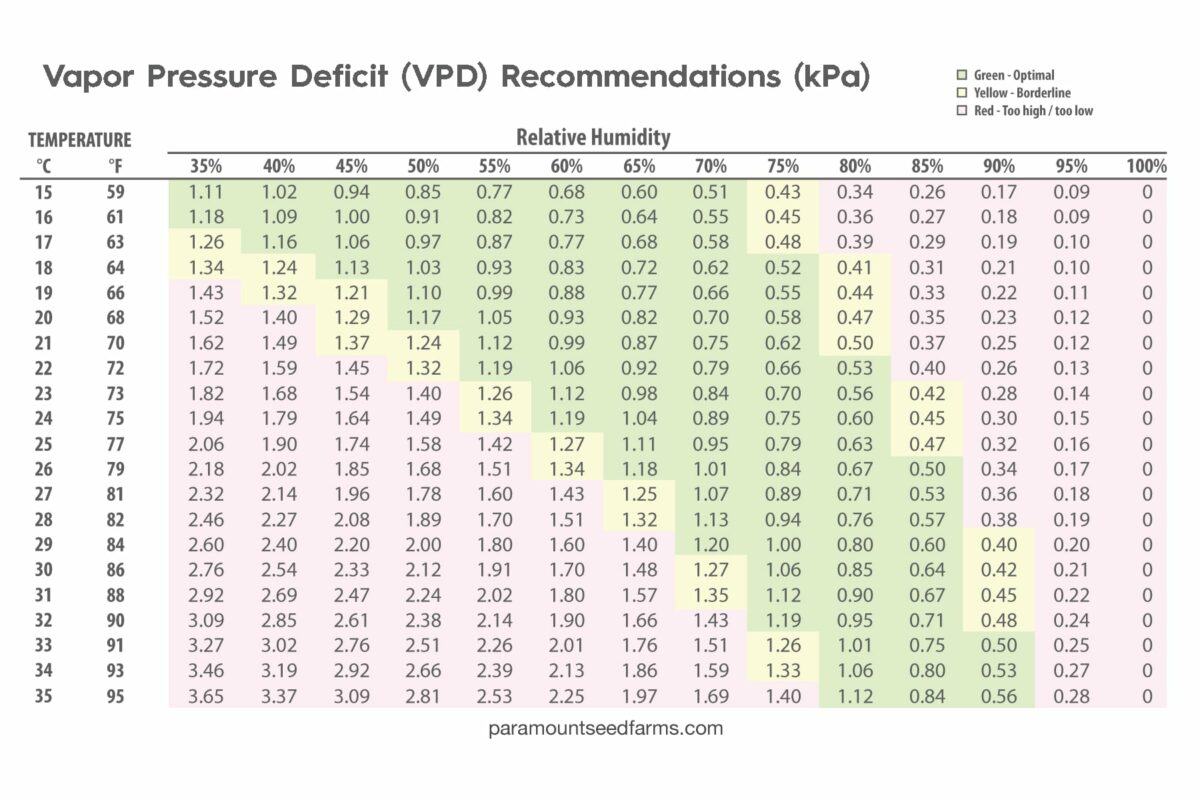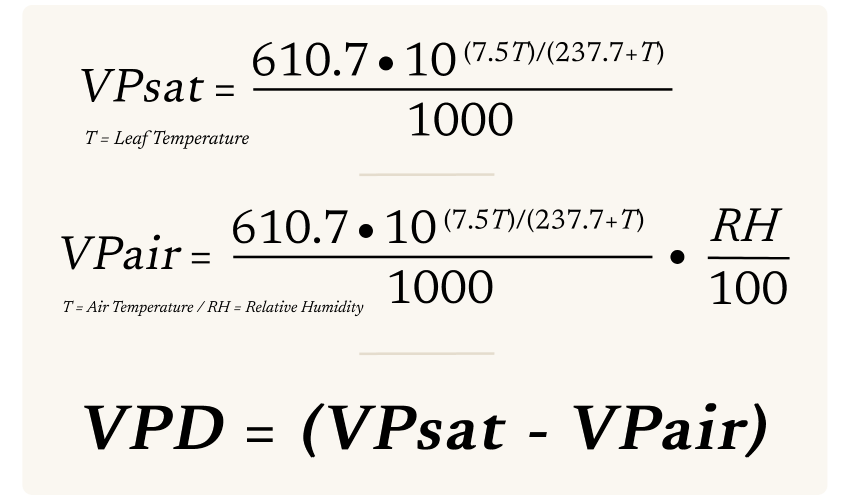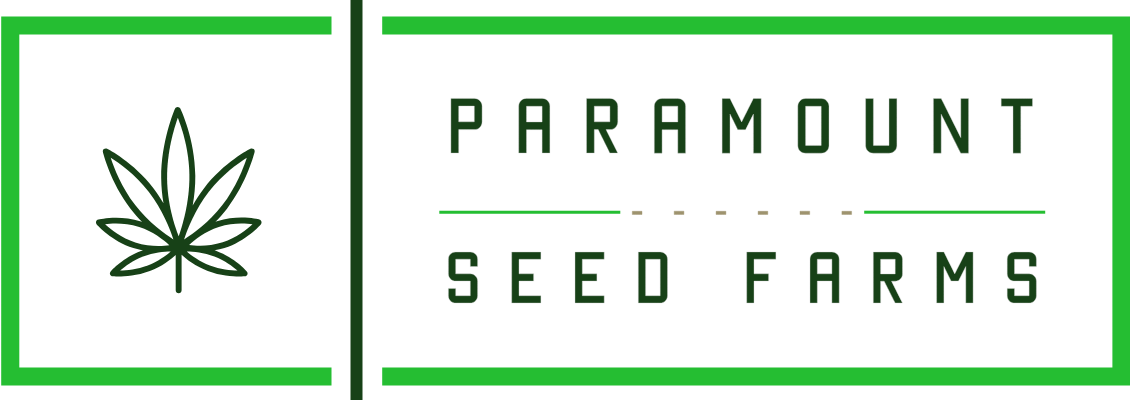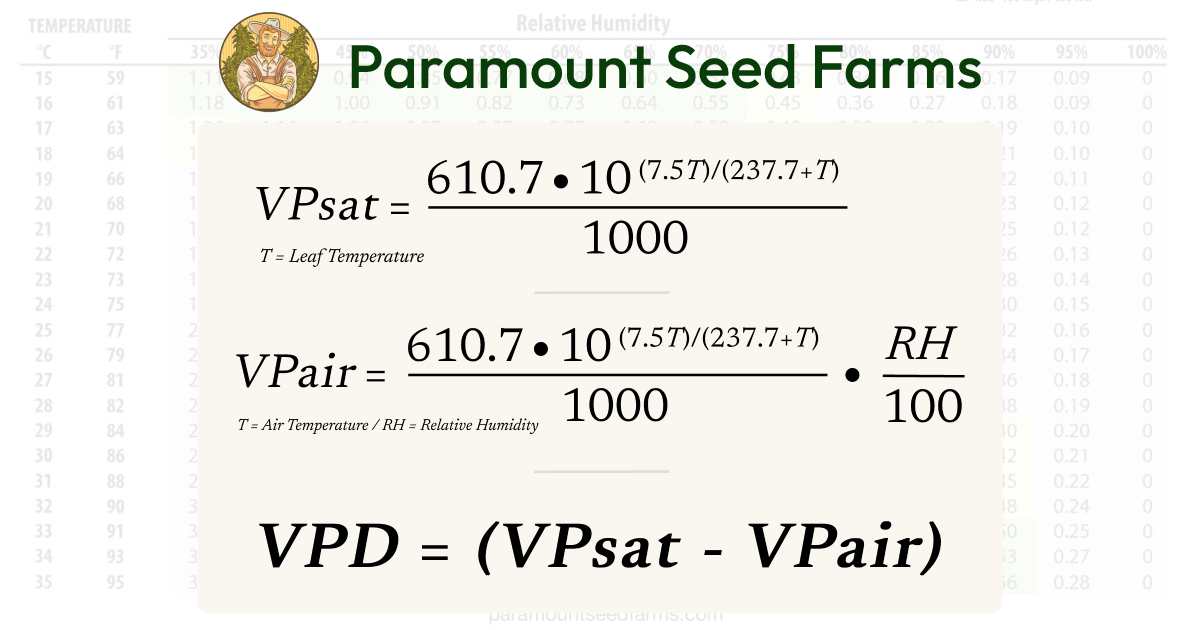The VPD chart below shows VPD levels widely accepted and recommended for growing cannabis. The top of this chart is the RH or Relative Humidity in your grow room. The left displays the temperature in both F and C of the air in and around the canopy of the plants. VPD (Vapor Pressure Deficit) is a control value for evaporation and plant transpiration.
What should my VPD be?
In the vegetative stage, your VPD should be 1kPa. In the flowering stage, your VPD should be 1.2 – 1.5kPa. A reliable VPD chart weed or cannabis vpd chart can be found below.
The vapor pressure deficit chart illustrates the relationship between temperature and relative humidity.

Results suggest that decreasing VPD improves plant water status, which ultimately enhances photosynthesis and growth under water stress.
Du Qingjie, Zhang Dalong, Jiao Xiaocong, Song Xiaoming, Liu Jianming
Published in Plant Soil and Environment | Citations: 9 | 2018
- Accurate Monitoring: Benefit from a premium sensor that offers an accuracy of ±3%RH and ±0.3°C/0.5°F. Our professional-grade components ensure trustworthy devices. For enhanced precision, calibrate the device to a trusted reference. Alternatively, consider the SensorPush HT.w or HTP.xw for superior accuracy right out of the box. Every SensorPush model provides dependable monitoring of environmental factors like air temperature, relative humidity, dew point, and VPD.
- Versatile: The HT1 design fits anywhere - from refrigerators to outdoor weather stations. It monitors humidity levels in household spaces like baby rooms or reptile tanks.
- Flexible Connectivity: Connect the sensor to your phone via Bluetooth or use the SensorPush G1 WiFi Gateway for internet access and alerts. Get notifications for deviations, ask Alexa for updates, or check data on our web dashboard. Great for remote monitoring in vacation homes, server rooms, or RVs (with cellular hotspots).
- Powerful Range: Experience a robust Bluetooth range of up to 325 feet, ensuring you stay informed from a distance. While physical barriers might reduce this range, many users successfully monitor challenging areas like walk-in coolers or rooftops. Its compact design, mounting convenience, and extended battery life (over 2 years typically) make it easy to position wherever needed.
- User-Friendly Interface: Set up effortlessly with our intuitive, free app (available for iOS and Android). Get a comprehensive digital overview of conditions across all connected SensorPush devices. Dive into detailed data logging and graphs with 20 days of onboard sensor storage and unlimited in-app storage. Export data to CSV for further analysis with tools like Excel or Google Sheets and calibrate with simplicity.
The values shown quantify VPD in KpA (kilopascals). The chart displays higher values indicating higher VPD, while lower values indicate lower VPD. It is ideal to have numbers within the green zone for optimal growth during vegetative and flowering stages. The provided cannabis VPD chart serves as a general resource for VPD in flowers, VPD in vegetation, VPD for LED lights, and more.
Plants transpire faster and root zones dry out more quickly when the VPD is higher. In situations with high VPD, nutrients accumulate faster and plants prioritize water over food. If you’re unable to address a high VPD situation, it’s advisable to feed plants conservatively to prevent over-feeding.
If VPD is too low, plants will start showing Calcium deficiencies, and more Calcium will not fix the problem. In low VPD environments, plants struggle to move Calcium through their tissue, and spots will begin on the leaves, starting at the top and moving down. Low VPD environments are also notorious for breeding fungal diseases like powdery mildew. Generating the above VPD chart for LED grow lights contain the ideal parameters if you grow using LED Grow Lights.
If the VPD of your grow environment is off, plants may exhibit traits of nutrient deficiency.
What is the ideal VPD for cannabis clones?
The ideal VPD for cannabis clones is around 0.8kPa
What is the perfect VPD for cannabis vegetative stage?
The ideal VPD for cannabis in the vegetative stage is around 1kPa. (Ideal VPD for veg stage and mother plants)
What is the ideal VPD for cannabis flowering stages?
The ideal VPD for cannabis in the flowering stage is 1.2 – 1.5kPa. (Ideal VPD for flower and best VPD for flowering stage)
What is VPD? VPD stands for Vapor Pressure Deficit. VPD consists of air temperature, leaf temperature, and relative humidity.
VPD dictates how efficiently a plant balances its internal energy with the broader environment. How well a plant can pick up or lose water, pump nutrients throughout, remain turgid and upright, and grow. VPD directly influences a plant’s hydraulic capacity and this, in turn, impacts growth rates and overall plant health.
Plants use a lot of water while growing, so the air in the growing space is usually pretty humid. But since the air in the plant’s leaves is usually much more humid than the air in the growing area, the pressure inside the leaf is typically much higher than the pressure inside the growing space. This difference in pressure causes water vapor to diffract (spread out) into smaller and smaller droplets until it’s almost all vaporized.
How is VPD calculated?
To calculate VPD, subtract the actual vapor pressure of the air from the saturated vapor pressure (VPsat – VPair). VPD (Vapor Pressure Deficit) in kilopascals (kPa) in grow rooms and cannabis-related gardens.
To find out how aggressively the environment is pulling air from the plant, we must compare the plants’ Saturated Vapor Pressure (if leaf temp is known) and the Vapor Pressure of the air.
To calculate VPsat, we need the temperature of the saturated environment -> the plant’s leaf. Measure this with an infrared temperature gun.
The formula for VPsat (in Kilopascals kPa) is:

To get VPair, we must know the temperature and humidity of the air, known together as relative humidity. We can measure this with a thermometer/hygrometer in the growing room.
The formula for VPair (in Kilopascals kPa) is:

VPD = (VPsat – VPair) is how VPD is calculated. See below:

And VOILA, you have VPD. Now it’s time to consult the VPD chart and your plants’ ideal growing temperature range to see if your VPD is within the correct range and your plant is transpiring healthily. Remember, each plant has its own correct VPD, so it’s essential to stick to the plants’ native temperature and consult the chart from there.

*Important Note: Prevent relative humidity from going over 80% or below 50%. If you cannot hit your desired targets, use the chart to find a combination that gets you as close to the green area as possible. Most growers understand that higher humidity is acceptable during the veg stage of growth. If you can control your environment with a humidifier and a dehumidifier, we suggest you shoot for a higher VPD during the vegetative growth stage. VPD and powdery mildew go hand-in-hand; maintain proper VPD to avoid powdery mildew infection.
The leaf surface temperature of your cannabis plants is critical to ensuring the best VPD for your environment and dialing your grow to optimal production.
Best VPD Monitoring Device
- Accurate Monitoring: Benefit from a premium sensor that offers an accuracy of ±3%RH and ±0.3°C/0.5°F. Our professional-grade components ensure trustworthy devices. For enhanced precision, calibrate the device to a trusted reference. Alternatively, consider the SensorPush HT.w or HTP.xw for superior accuracy right out of the box. Every SensorPush model provides dependable monitoring of environmental factors like air temperature, relative humidity, dew point, and VPD.
- Versatile: The HT1 design fits anywhere - from refrigerators to outdoor weather stations. It monitors humidity levels in household spaces like baby rooms or reptile tanks.
- Flexible Connectivity: Connect the sensor to your phone via Bluetooth or use the SensorPush G1 WiFi Gateway for internet access and alerts. Get notifications for deviations, ask Alexa for updates, or check data on our web dashboard. Great for remote monitoring in vacation homes, server rooms, or RVs (with cellular hotspots).
- Powerful Range: Experience a robust Bluetooth range of up to 325 feet, ensuring you stay informed from a distance. While physical barriers might reduce this range, many users successfully monitor challenging areas like walk-in coolers or rooftops. Its compact design, mounting convenience, and extended battery life (over 2 years typically) make it easy to position wherever needed.
- User-Friendly Interface: Set up effortlessly with our intuitive, free app (available for iOS and Android). Get a comprehensive digital overview of conditions across all connected SensorPush devices. Dive into detailed data logging and graphs with 20 days of onboard sensor storage and unlimited in-app storage. Export data to CSV for further analysis with tools like Excel or Google Sheets and calibrate with simplicity.
Final Word
Proper HVAC equipment design → consistent temperature and relative humidity in the space → consistent vapor pressure deficit → plant transpiration → plant growth.
The growth of cannabis plants depends on humidity and temperature. Even slight fluctuations in these factors can greatly affect the amount of water vapor in the air, known as vapor pressure differential. The size, cost, and efficiency of the HVAC system, as well as the control measures implemented to promote optimal plant growth, are determined by the specific requirements for adding or removing air and water within a given timeframe in the growing area.
A great VPD resource and exciting concept for VPD – vpdchart.com
Some of the data and info in this article was original research found here:
L Breit, M Leavitt, A Boyd, Cannabis Science and Technology 2(2), 52-61 (2019).


